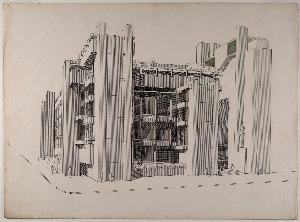Paul Marvin Rudolph
Paul Marvin Rudolph;Paul Rudolph
Place: Elkton
Born: 1918
Death: 1997
Biography:
Paul Marvin Rudolph was an American architect, born on October 23, 1918, in Elkton, Kentucky. He is known for his use of reinforced concrete and highly complex floor plans, which made him one of the modernist architects considered an early practitioner of the Sarasota School of Architecture.
Early Life and Education
Rudolph's interest in architecture began at a young age, and he went on to study at the Yale University School of Architecture. After completing his studies, he became the chair of the Department of Architecture at Yale University for six years.
Notable Works
Some of Rudolph's notable works include Paul Marvin Rudolph's design for the Yale University Art Gallery, which features a unique blend of modern and traditional architectural styles. His use of reinforced concrete and complex floor plans has been widely praised by critics and architects alike.
Influence on Modern Architecture
Rudolph's work had a significant influence on the development of modern architecture in the United States. His designs, which often featured large open spaces and complex geometries, have been studied by many architects around the world. reinforced concrete was a key element in his designs, allowing him to create structures that were both functional and aesthetically pleasing.
Legacy
Rudolph's legacy can be seen in many of his works, including the Yale University Art Gallery, which is now considered a landmark of modern architecture. His influence on the development of modern architecture is still felt today, with many architects continuing to study and draw inspiration from his designs.
- Paul Marvin Rudolph's work can be seen on Wikioo.org, which features a wide range of his designs and architectural plans.
- More information about Rudolph's life and work can be found on The Museum Frieder Burda (Germany) - A Haven for Art Lovers, which features a collection of modern and contemporary art.
- Rudolph's designs have been widely praised by critics, including those at the Staedtische Galerie im Lenbachhaus, which is one of the most renowned art museums in Germany.
Conclusion
Paul Marvin Rudolph was a pioneering architect who left an indelible mark on the world of modern architecture. His use of reinforced concrete and complex floor plans has inspired generations of architects, and his designs continue to be studied and admired today. As a leading figure in the development of modern architecture, Rudolph's legacy will continue to be felt for years to come.

![Yale Art and Architecture Building, New Haven, CT; [exterior perspective] Yale Art and Architecture Building, New Haven, CT; [exterior perspective]](https://img.wikioo.org/ADC/art.nsf/get_small_image_wikioo?Open&ra=D5GVP7)